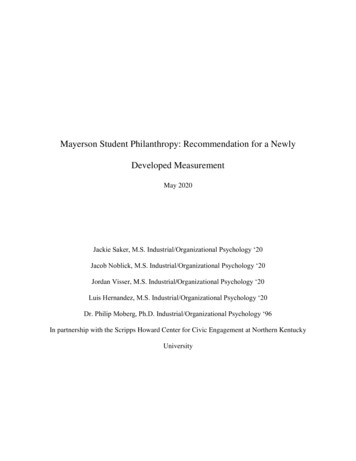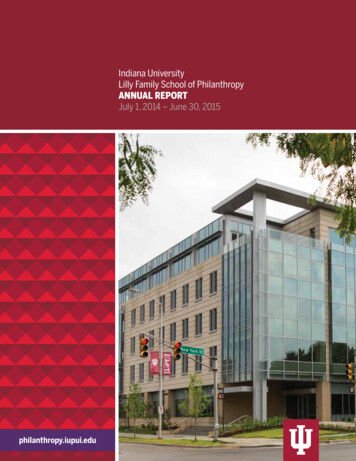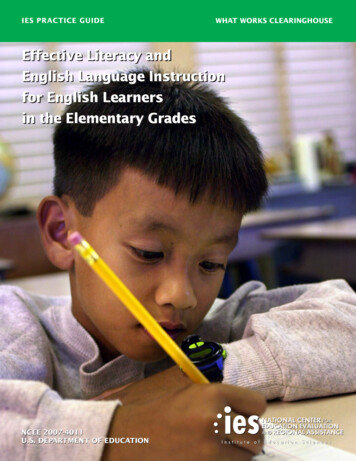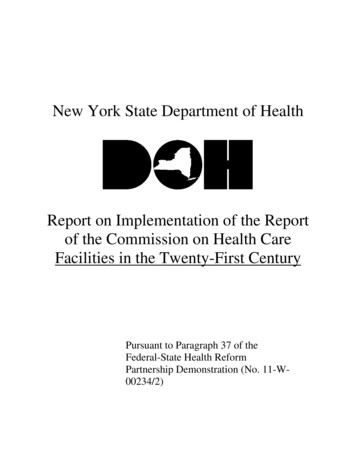
Transcription
Mayerson Student Philanthropy: Recommendation for a NewlyDeveloped MeasurementMay 2020Jackie Saker, M.S. Industrial/Organizational Psychology ‘20Jacob Noblick, M.S. Industrial/Organizational Psychology ‘20Jordan Visser, M.S. Industrial/Organizational Psychology ‘20Luis Hernandez, M.S. Industrial/Organizational Psychology ‘20Dr. Philip Moberg, Ph.D. Industrial/Organizational Psychology ‘96In partnership with the Scripps Howard Center for Civic Engagement at Northern KentuckyUniversity
MAYERSON PROJECT SURVEY2Table of ContentsNote to Sponsor .3Executive Summary .4Background and Statement of the Problem .5Constructs .6The Purpose of an Exploratory Factor Analysis .10Method .11Inspecting the Data 11Forming Groups 12Exploratory Factor Analysis .13Results .15Attitudes, Beliefs, Values, and Intentions .15The Effect of the Mayerson Class Experience .18Recommendations .19References .22Appendices 24
MAYERSON PROJECT SURVEY3Note to SponsorWe would like to take a moment to thank the Scripps Howard Center of CivicEngagement and the Masters of Industrial and Organizational Psychology program at NorthernKentucky University for the opportunity to lead this project. A special thanks to Mark Neikirkand Dr. Kajsa Larson for their guidance and support in shaping this project, without their insightsthis project would not have been possible. A final thank you to Dr. Philip Moberg for hisinvolvement in the project and willingness to always lend a helping hand and a listening ear.
MAYERSON PROJECT SURVEY4Executive SummaryCurrent graduate students of the Master of Science in Industrial-OrganizationalPsychology program at Northern Kentucky University consulted Dr. Kajsa Larson and MarkNeikirk, sponsors for the Scripps-Howard Center for Civic Engagement, in regards to theirMayerson Student Philanthropy Project assessment tool. The purpose of the capstone project wasto evaluate, investigate, and provide recommendations for a new Mayerson Student PhilanthropyProject assessment tool. The Scripps-Howard Center has been using the current assessment toolfor the last 20 years to collect information about attitudes, beliefs, values and intentions towardsphilanthropy and the effect of the Mayerson class experience. An exploratory factor analysis ofthe data found that there are inconsistencies in factor structure between the Pretest and Posttest,and across groups (e.g., college and focus of study). Based on the findings from the analysis ofthe data, interviews with staff involved with the Mayerson project, and a review of the literature,a new measurement tool was developed for consideration to use moving forward.
MAYERSON PROJECT SURVEY5Background and Statement of the ProblemThe Mayerson Student Philanthropy Project is an initiative housed in Northern KentuckyUniversity’s Scripps Howard Center for Civic Engagement and was developed in 1999 as a wayto teach students about the activities of local nonprofit organizations and philanthropy. NKUstudents learn about nonprofits and philanthropy hands-on, following a “learn by giving”approach. In this approach, students have the opportunity to evaluate local nonprofits and investa sum of money into nonprofits that would make effective use of the funds. During theevaluation stage, students learn about the needs of their community, the important impactnonprofits have, and engage in scholarly activities that combine the course work of the class andphilanthropic missions. The goal of the Mayerson Student Philanthropy Project is to developNKU graduates who remain life-long stewards in their communities. Additionally, this hands-onlearning approach ideally promotes greater student engagement in the classroom and community,enhances learning, and improves student retention at NKU.To measure the benefits of the Mayerson Project, pretest and posttest surveys weredesigned to assess the following dimensions: stewardship, classroom engagement, communityengagement, and intention to stay. These dimensions are measured as attitudes, intentions, and/orbehaviors. Attitudes reflect the values and beliefs that underlie an individual’s disposition towarda certain concept (Lee, 2011). Intention refers to an individual’s likelihood of participating in aspecific activity while behavior refers to an individual’s actually engaging in those specificactions (Lee, 2011). In the surveys, the stewardship dimension is defined using attitudes andintentions, the individual’s feeling of responsibility to the community, and the individual’slikelihood of engaging in activities that protect the community’s wellbeing. Classroomengagement is measured using behavioral and attitudinal questions, such as how the individual
MAYERSON PROJECT SURVEY6participates in the classroom and their belief in the importance of that participation. Likewise,community engagement is also measured using attitude, the individual’s desire to learn about theneeds in the community, but also intentions, the individual’s likelihood of bringing positivechange to meet those needs. While, intention to stay is measured using intentional questions,based on the individual’s likelihood to complete their degree at NKU. In the posttest survey, twoadditional dimensions, community awareness, and Mayerson experience also are assessed.Community awareness, the participants’ understanding of the needs in their community, ismeasured as a behavior. The participant’s involvement with and feeling toward the MayersonProject, is measured both as a behavior and an attitude.ConstructsAlthough stewardship as a concept in social science research has a number of varyingdefinitions, they do tend to contain similar themes and components. One of the most commonlyused and empirically validated interpretations proposes four basic principles to stewardship:reciprocity, responsibility, reporting, and relationship building. In the context of non-profitorganizations’ efforts to gather donor support, these four principles of stewardship have beenidentified as critical (Li, et al, 2019). A more general description of stewardship used by someresearchers is a collectively minded attitude and behavior of being in the service of others andputting the common good above one's own (Dominguez, et al, 2019). As part of our pursuit todefine our constructs, we had several discussions with Mark Neikirk at the Scripps HowardCenter for Civic Engagement in which an idea of “stewardship of community” was determinedto be a central component of what we would be trying to measure. Mark described Stewardshipof place “as to care about where you live, to take ownership with other members of thecommunity of the needs and concerns for your place.” and “‘Place”’ is probably best thought of
MAYERSON PROJECT SURVEY7as ‘community’ and that could be geographic (a neighborhood in Newport, for example), a group(immigrants living in our region, for example, or families with special needs children, etc.) oreven a topical community (e.g., addressing a region’s heroin epidemic).” (M. Neikirk, personalcommunication, 2020). To best encapsulate these varying definitions in a way which serves theneeds of Scripps Howard, stewardship has been conceptualized as attitudes and beliefs related toone's responsibility to care for, and improve one's community. Standing on these constructs canbe examined before and after the service learning project to evaluate the effect it had on theimportance of stewardship to the individual student.One construct frequently measured in organizational research settings is engagement.Engagement refers to “a positive, fulfilling, and work-related state of mind that is characterizedby vigor, dedication, and absorption” (Schaufeli, Martinez, Pinto, Salanova, & Bakker, 2002).There were two types of engagement identified for the Mayerson project, classroom engagementand community engagement. Classroom engagement, similar to academic engagement, generallyrefers to “academic-related processes in which students engage in their schooling” (Chen, 2005).This type of engagement refers to behavioral processes such as demonstrating the appropriateclassroom conduct and instrumental processes such as time spent working on homework (Chen,2005). Classroom engagement is a common theme among higher education because it deals withthe student’s individual willingness to participate in class discussions and to be engaged with thematerial. Much of the literature suggests that it is the role of the teacher to help create anenvironment in which students are challenged and feel comfortable to ask questions (Savory,Goodburn, & Kellas, 2012). Based on the literature and Mark Neikirk’s definition of classroomengagement, it was defined as an individual’s active participation in learning class content aswell as interacting with others in the classroom. This refers to how much the student participates
MAYERSON PROJECT SURVEY8in class over the span of the semester with the implementation of the Mayerson StudentPhilanthropy project component. This also refers to how active the student is with other studentsand if they engage in classroom discussions or general discussions about the service project.The other type of engagement defined for this project was community engagement.Community engagement differs slightly from the civic engagement and the notion of communityservice. Although scant literature defines community engagement in a service learningenvironment, it can generally be defined as a way “to better engage the community to achievelong-term and sustainable outcomes, processes, relationships, discourse, decision-making, orimplementation” (What is Community Engagement? n.d.). The construct assessed in this projectfocuses more on student attitudes and intentions. Community engagement differs from the ideaof community service because engagement is not simply about having students volunteer more.Based on what literature could be found along with the definition that Mark Neikirk provided,we defined community engagement as an individual’s desire to learn about the needs of theircommunity and intent to bring positive change to meet those needs. The Mayerson Project aimsat encouraging students to be more involved in addressing the needs of the community. The goalwas to connect the students to their communities by understanding the needs of their communityand learning how to address those needs in a productive and effective way.In organizational psychology, intention to stay refers to an employee’s level ofcommitment to their organization and their willingness to remain employed (Mustapha, Ahmad,Uli, & Idris, 2011). When applied to education, intention to stay refers to a student’s level ofcommitment to the completion of their degree and their willingness to stay at their currentinstitution. Based on the definition of intention to stay in academic literature and Mark Neikirk’s,Executive Director of NKU’s Scripps Howard Center, understanding of the scope of intention to
MAYERSON PROJECT SURVEY9stay in relation to the Mayerson Project, intention to stay can be understood as both persistenceand retention. Retention refers to the short-term aspect of intention to stay and relates tostudents’ commitment and willingness to come back to NKU on a semester by semester basis.Persistence is the long-term aspect of intention to stay and refers to students’ commitment andwillingness to stay at their institution to receive their degree. Involvement in the MayersonProject is believed to increase students’ intention to stay, by connecting students to thecommunity through exploring local nonprofits to increase students commitment to andwillingness to stay in the community. The Mayerson Project also provides hands-on experiencesin learning course material, connecting the students more strongly to what is being learned in theclassroom, and increasing both their commitment and willingness to stay.The purpose of a survey is to capture participants’ attitudes, feelings, and/or perceptionsabout specific topics to understand what’s making an impact on important outcomes such asintent to stay, classroom engagement, and community engagement. An important component of asurvey is the validity of items measuring the intended focus as they will impact insights that canbe drawn from the data analysis. This is dependent on the extent to which participants interpretthe items in a conceptually similar manner, and this becomes crucial if different groups (e.g.,students from the College of Business and Arts & Sciences) are taking the survey. Because ofthese reasons, it is essential to have a valid and reliable survey that has the statistical propertiesthat will provide meaningful insights into the topics being evaluated. A first step for establishinga measurement’s psychometric properties is by conducting an Exploratory Factor Analysis(EFA) of response data.
MAYERSON PROJECT SURVEY10The Purpose of an Exploratory Factor Analysis (EFA)The purpose of an EFA is to analyze the relationships (i.e., correlations) in a set of itemsin a survey (Tabachnick & Fidell, 2013). Items that are highly interrelated form factors meaningthat they are interpreted in a conceptually similar way by participants. Interpretation and namingof the factors depend on the common theme/s of the items that comprise the factor. Conductingan EFA on a survey’s items helps answer important questions concerning the number ofconstructs (i.e., factors) being measured, the interpretation of these factors, and if the samepattern of factors is found consistently across different groups.How many factors are in the Mayerson Philanthropy survey? The primary question seeksto answer the nature of how participants are interpreting the items and the number of factorscontained in the survey. This information is helpful for understanding the potential constructsbeing measured by the survey. This is the first step in uncovering the usability of the Philanthropysurvey.Are the factors found consistently across different groups of students? This survey has beenadministered to students from varied disciplines. Each college at Northern Kentucky has differentareas of specialties that reflect different perspectives and each has its own unique history. Becauseof this, students’ interpretations of survey items may be influenced by the perspectives in whatthey are studying. Taking this into consideration, the factors, in theory, should be foundconsistently across different groups which would indicate that students across disciplines interpretthe items in a conceptually similar manner. For this question, we are interested in establishingmeasurement invariance and avoiding construct bias. Lee (2018) described measurementinvariance as participants from different groups interpreting the items within a measure in aconceptually similar manner. Furr (2018) defined construct bias as occurring when a survey has a
MAYERSON PROJECT SURVEY11different meaning for different groups. If the factors are found consistently across different groupsof students, then the survey is said to have measurement invariance and the items are said reflectthe same meaning for all students who complete the survey at NKU.What constructs do the factors in the Mayerson Philanthropy survey represent? Dependingupon the findings to the two previous questions, if the survey demonstrates measurementinvariance then the final step is defining the factors that are revealed. This information is useful todescribe what the items in the survey are statistically and conceptually measuring. The process isinvolves finding a consistent theme shared by the set of items that form a factor that can beinterpreted to represent a potential construct.MethodInspecting the DataAn EFA examines correlations to understand the relationships between the items in asurvey. A limitation of correlation analysis is that it is dependent on having an adequate samplesize. If this requirement is not met then the analysis will produce less reliable estimates(Tabachnick & Fidell, 2013). Following the guidelines established by Schultz, Whitney, andZickar (2014), it is recommended to have a sample size of at least (5 x #items) 100 to conductan EFA. This means that for the Pretest EFA, the minimum required sample size is N 175 andfor the Posttest, which includes additional items, is N 220.The total number of participants who submitted Pretest surveys was N 2,550 and N 2,207 for the Posttest survey. The data was inspected for missing responses and normality in thedistribution as determined by skewness and kurtosis analysis. Participants with an excess amountof missing data can indicate potential response biases that distort interpretation, if included. Thenumber of missing responses ranged from 1 (skipped one item) to 42 (did not answer any items).
MAYERSON PROJECT SURVEY12This is problematic because it impacts analysis and may produce less reliable findings. Becauseof this, all cases that were missing 3 or more responses were removed and those missing 1 or 2responses were replaced by the missing items’ overall group means. The final sample size for thePretest survey was N 2,035 and N 1,738 for the Posttest survey, which satisfy the minimumrequired sample sizes of 175 and 220, respectively.Next, the items were inspected for normality by conducting a skewness and kurtosisanalysis. Skewness and kurtosis issues limit analysis and interpretation, and impact estimations.It is recommended by Tabachnick and Fidell (2013) to apply one of three transformations –Square Root (moderate issues), Logarithmic, and Inverse (severe issues) to correct for skewed orkurtotic data distributions. The analysis found that most of the items had some degree ofskewness and kurtosis issues. However, when each transformation was applied in an effort toachieve normally distributions of data, the issues worsened. Because of this, no transformationswere applied and the items remained in raw format for analysis.Forming GroupsAdditional groups were created to analyze for measurement invariance grouped bycollege or academic focus. For the college groups, the course demographic information was usedto first verify the abbreviation and section numbers appearing in Northern Kentucky’s coursecatalog. Next, the course's college was confirmed using Northern Kentucky’s academic website.This website provides links to all the colleges with a list of majors and classes. Three of theseven college groups met the minimum required sample size for the Pretest (N 175) andPosttest (N 220) to conduct an EFA. Business (N 84 and 83), Education (N 109 and 106),Honors (N 44 and 41), and School of the Arts (N 93 and 79) did not meet the sample size
MAYERSON PROJECT SURVEY13requirement. To include these responses, we decided to combine all four groups into one samplefor analysis. A summary of the college groups sample information is provided in Table 1.Table 1. Sample Size (N) of College GroupsCollegePretest N* Posttest N**Arts & Sciences982784Health & Human Services436403Informatics287242Other (Business, Education, Honors, 330309and School of the Arts)Total20351738Note: The "Other" group reflects courses that were combined tomeet the minimum required sample size (175* and 220**)needed to conduct a stable EFA.For the Focus of Study groups, the courses were inspected for commonalities in contentbased on the data analyst subjective judgment. For example, English, Spanish and Germancourses were grouped together to represent “Language Studies” and Organizational Leadership,Entrepreneurship, Marketing, and Business Informatics as “Business Studies”. As previouslynoted, the minimum required sample size (i.e., Pretest N 175, Posttest N 220) was taken intoconsideration when forming these groups. All groups met the minimum required sample sizewith the exception of the Society and Human Studies (N 216) and Business Studies (N 218)groups in the Posttest survey. Because the difference was minimal we decided that these twogroups would be included in the analysis. A summary of the Focus of Study groups sample sizeinformation along with the group’s courses sample size is provided in Table 2.Exploratory Factor AnalysisThree sets of exploratory factor analysis (EFA) with principal axis factoring using directoblimin rotation were performed each with three different groups. The first set of EFA’s wasperformed using the Pretest items (15 total) aiming to measure attitudes, beliefs, values, andintentions towards philanthropy. The groups include Overall (everyone that took the survey), by
MAYERSON PROJECT SURVEY14College (based on course listing on Northern Kentucky University website), and by Focus ofStudy (subjectively assigned based on commonalities among courses). This methodology wasapplied for the second set of EFA’s using the Posttest items (15 total) measuring attitudes,beliefs, values, and intentions towards philanthropy. The final set of EFA’s performed used thePosttest items (24 total) aiming to measure the effect of the Mayerson class experience. This setof EFA’s includes the same groups discussed previously. In total, nine EFA’s were performed toanalyze the factor structure of the Mayerson Philanthropy survey.Dr. Philip Moberg (2020, personal communication), provided three guidelines foridentifying items that represent the factors uncovered. The first guideline is that if an item has aloading of .35 or greater on a factor then it is included as representing that factor. However, if theitem cross-loads at .30 or greater on another factor then it is unclear to which factor the item“belongs” and it is excluded. The second guideline is that if an item loads at .30 or less on afactor it is considered as not representing that factor. Finally, the third guideline is that if an itemhas a loading between .30-.35 then the item is considered to be ambiguous in terms of factoridentity and should be either disregarded or rewritten for future administration. The guidelineswill serve as the foundation for interpreting the exploratory factor analysis and discussing thefactors that emerge.Table 2. Sample Size of Groups by Focus of StudyGroups by Focus of Study and Course InformationLanguage StudiesEnglishSpanishGermanAssisting Professions StudiesSocial WorkHuman Services/Mental HealthNursingPretest N37322611433Posttest N3241911023143627667403265619377
MAYERSON PROJECT SURVEY15Society and Human StudiesCommunication 1721866192181101469Public Services StudiesCriminal JusticePublic AdministrationHistory31282113709925220886171Other StudiesHonorsLibrary InformaticsTheatre and DanceEnvironmental 2106020351738Business StudiesOrganizational LeadershipEntrepreneurshipMarketingBusiness InformaticsTotalNote: Posttest groups of Society and Human Studies and Business Studies did not meet the required samplesize to conduct an EFA (N 220). However, the difference was minimal and both groups were retained foranalysis.ResultsAttitudes, Beliefs, Values, and IntentionsIn this section, an exploratory factor analysis with principal axis factoring and directoblimin rotation was performed on the 15 items measuring attitudes, beliefs, values, andintentions towards philanthropy. Two separate EFA’s were performed, one using the items fromPretest surveys and a second using items from the Posttest surveys. The Posttest analysisincluded all participants representing the aggregate sample group. This was followed by severaladditional EFAs conducted using data representing Colleges and Focus of Study groups and formeasurement invariance analysis.
MAYERSON PROJECT SURVEY16Pretest and Posttest Aggregate Group FindingsFor the Pretest EFA, three factors were found and item Q2 12 did not load onto any ofthe factors. Based on the common themes identified in items forming each factors, Factor 1reflects attitudes and beliefs towards proactivity (9 items). Items in this factor are based onmaking a positive contribution in different aspects of life (e.g., community, education). Factor 2reflects Community Awareness (2 items) and Factor 3 reflects Charitable Investment (3 items)(Appendix A).For the Posttest EFA, two factors were found and item Q2 03 did not load onto any ofthe factors. Factor 1 reflects philanthropic orientation (11 items) representing views andintentions towards giving back. Factor 2 reflects knowledge disposition (3 items) but it'simportant to note that item Q2 05 may not completely represent this theme (Appendix A).Comparing the pretest and posttest EFA findings, Factor 1 had similar items, however,the items that loaded on Factor 3 (Q2 13, Q2 14, Q2 15) in the pretest loaded on Factor 1 in theposttest. Additionally, Factor 2 in the posttest included item Q2 05 which loaded on Factor 1 inthe Pretest. These findings demonstrate construct bias as the factor structure was different for thePretest overall group and the Posttest overall group. Appendix A provides a summary of thesefindings.Pretest and Groups FindingsComparing factor structure of the aggregate group with the College groups, Factor 1(attitudes and beliefs towards proactivity) was found in three of the four groups with minordifferences. Those groups were the Arts & Sciences (cross-loaded item, Q2 11), Health &Human Services, and Other (cross-loaded item, Q2 05). Factors 2 (community awareness) and 3(charitable investment) were found in all groups. However, item Q2 11 in Factor 3 for the
MAYERSON PROJECT SURVEY17groups of Arts & Sciences and Informatics cross-loaded with Factor 1. Overall, the findingsdemonstrate measurement invariance when comparing the College groups’ factors with theOverall Pretest group’s factors. In other words, the same factors were found in each of theCollege groups samples suggesting that the factors measured by the current scale appear in thesame way across very different academic colleges. Appendix B provides a summary of thesefindings.Comparing group results by Focus of Study, Factor 1 (attitudes and beliefs towardsproactivity), was found in four of the six groups with minor differences. Those groups wereLanguage Studies (cross-loaded items, Q2 06 and Q2 11), Assisting Professions studies (Q2 12did not load for the Overall group), Business studies (item Q2 06 did not load), and Otherstudies. Factor 2 (community awareness) was found across all groups and Factor 3 (charitableinvestment) was found in four of six groups with minor differences. For Factor 3, those groupswere Assisting Professions studies, Society & Human studies (Q2 15 did not load), Businessstudies, and Other studies. Overall, the findings demonstrate general consistency but notmeasurement invariance when comparing the Focus of Study groups’ factors with the OverallPretest group’s factors. In other words, the factors are measuring similar, but not the exact sameconstruct across Focus of Study groups. Appendix C provides a summary of these findings.Posttest and Groups FindingsComparing by College, Factor 1 (philanthropic orientation) was found in two of the fourgroups – Arts & Sciences (cross-loaded item, Q2 10) and Informatics. Factor 2 (knowledgedisposition) was not found in any of the groups. Overall, the findings demonstrate construct biaswhen comparing the College groups’ factors with the Overall group’s factors. Appendix Dprovides a summary of the findings.
MAYERSON PROJECT SURVEY18Comparing by Focus of Study, Factor 1 (philanthropic orientation) was found in four ofthe six groups with minor differences. Those groups were Language studies (cross-loaded item,Q2 10; item Q2-03 did not load for the Overall group), Society & Humanities studies (item Q203 did not load for the Overall group), Business studies, and Other studies. Factor 2 (knowledgedisposition) was found in four of the six groups with minor differences. Those groups wereLanguage studies (cross-loaded item, Q2 10), Society & Humanities studies, Business studies(Q2 03 did not load for the Overall group), and Other studies (Q2 03 did not load for theOverall group). Although similar constructs were found, the results do not demonstratemeasurement invariance when comparing Focus of Study group factors with the Overall Posttestgroup factors. Appendix E provides a summary of these findings.The Effect of the Mayerson Class ExperienceAn EFA with principal axis factoring and direct oblimin rotation was performed on the24 items measuring the effect of the Mayerson Class Experience. The first EFA was performedwith all participants representing the aggregate Overall group followed by the groupsrepresenting Colleges and Focus of Study subsamples for measurement invariance analysis.FindingsFactor 1 in the Overall group was made up of 15 items that reflect several theme. Thosereflect knowledge assessment (Q3 1, Q3 2, Q3 8, Q3 10, Q3 16, Q3 17) philanthropicengagement (Q3 3, Q3 4, Q3 5, Q3 6, Q3 7, Q3 15, Q3 18, Q3 19), and academicachievement (Q3 9). Factor 2 in the Overall group was made up of 9 items reflecting communalresponsibility (Q3 11, Q3 12, Q3 20), classroom engagement (Q3 13, Q3 14), philanthropicintentions (Q3 21, Q3 22, Q3 23, Q3 24). Neither Factors 1 nor 2 were found in the Collegegroups (Appendix F) or Focus of Study groups (Appendix G) when compared to the aggregate
MAYERSON PROJECT SURVEY19Overall group’s factors. These inconsistencies demonstrate that the factors measured in thecurrent survey are unstable and change across samples. In other words, the current surveymeasures different constructs in different samples, rather than consistently assessing onecommon constructs, providing clear evidence of construct bias and the need for revision orreplacement.RecommendationsAn exploratory factor analysis p
Current graduate students of the Master of Science in Industrial-Organizational Psychology program at Northern Kentucky University consulted Dr. Kajsa Larson and Mark Neikirk, sponsors for the Scripps-Howard Center for Civic Engagement, in regards to their Mayerson Student Philanthropy Project assessment tool.










